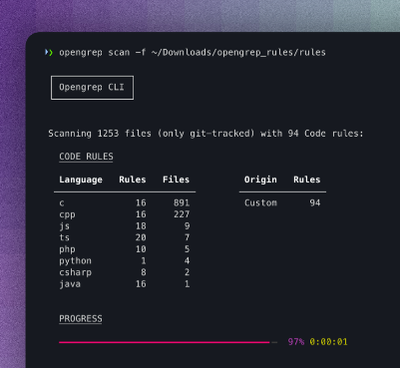
Security News
Opengrep Emerges as Open Source Alternative Amid Semgrep Licensing Controversy
Opengrep forks Semgrep to preserve open source SAST in response to controversial licensing changes.
rdf-data-factory
Advanced tools
A TypeScript/JavaScript implementation of the RDF/JS data factory.
This package contains an implementation of the RDF/JS Data model. It works in both JavaScript and TypeScript.
Concretely, it provides an implementation of the following interfaces:
DataFactory: A factory for instantiating RDF terms and quads.NamedNode: A term that contains an IRI.BlankNode: A term that represents an RDF blank node with a label.Literal: A term that represents an RDF literal, containing a string with an optional language tag and optional direction or datatype.Variable: A term that represents a variable.DefaultGraph: A singleton term instance that represents the default graph.If using TypeScript, it is recommended to use this in conjunction with @types/rdf-js.
$ npm install rdf-data-factory
or
$ yarn add rdf-data-factory
This package also works out-of-the-box in browsers via tools such as webpack and browserify.
It is recommended to always create terms via a DataFactory instance:
import { DataFactory } from 'rdf-data-factory';
import * as RDF from 'rdf-js';
const factory: RDF.DataFactory = new DataFactory();
You can pass the following option to define a blank node prefix:
const factory: RDF.DataFactory = new DataFactory({ blankNodePrefix: 'bnode_' });
If no blankNodePrefix is passed, it will generate a unique prefix of the form df_[0-9]+_,
which ensures there will be no blank nodes clashes when instantiating multiple factories.
const term: RDF.NamedNode = factory.namedNode('http://example.org');
console.log(term.value); // 'http://example.org'
console.log(term.termType); // 'NamedNode'
console.log(term.equals(term)); // true
With a given blank node label:
const term: RDF.BlankNode = factory.blankNode('bnode');
console.log(term.value); // 'bnode'
console.log(term.termType); // 'BlankNode'
console.log(term.equals(term)); // true
Autogenerate a blank node label using an internal blank node counter:
const term: RDF.BlankNode = factory.blankNode();
console.log(term.value); // 'df-0'
console.log(term.termType); // 'BlankNode'
console.log(term.equals(term)); // true
Reset the blank node label counter:
factory.resetBlankNodeCounter();
Plain string literal:
const term: RDF.Literal = factory.literal('abc');
console.log(term.value); // 'abc'
console.log(term.termType); // 'Literal'
console.log(term.language); // ''
console.log(term.direction); // ''
console.log(term.datatype); // namedNode('http://www.w3.org/2001/XMLSchema#string')
console.log(term.equals(term)); // true
Languaged tagged string literal:
const term: RDF.Literal = factory.literal('abc', 'en-us');
console.log(term.value); // 'abc'
console.log(term.termType); // 'Literal'
console.log(term.language); // 'en-us'
console.log(term.direction); // ''
console.log(term.datatype); // namedNode('http://www.w3.org/1999/02/22-rdf-syntax-ns#langString')
console.log(term.equals(term)); // true
Directional languaged tagged string literal:
const term: RDF.Literal = factory.literal('abc', { language: 'en-us', direction: 'ltr' });
console.log(term.value); // 'abc'
console.log(term.termType); // 'Literal'
console.log(term.language); // 'en-us'
console.log(term.direction); // 'ltr'
console.log(term.datatype); // namedNode('http://www.w3.org/1999/02/22-rdf-syntax-ns#dirLangString')
console.log(term.equals(term)); // true
Datatyped literal:
const term: RDF.Literal = factory.literal('1.2', factory.namedNode('http://www.w3.org/2001/XMLSchema#double'));
console.log(term.value); // 'abc'
console.log(term.termType); // 'Literal'
console.log(term.language); // ''
console.log(term.direction); // ''
console.log(term.datatype); // namedNode('http://www.w3.org/2001/XMLSchema#double')
console.log(term.equals(term)); // true
const term: RDF.Variable = factory.variable('myVar');
console.log(term.value); // 'myVar'
console.log(term.termType); // 'Variable'
console.log(term.equals(term)); // true
This will always produce the same default graph instance;
const term: RDF.DefaultGraph = factory.defaultGraph();
console.log(term.value); // ''
console.log(term.termType); // 'DefaultGraph'
console.log(term.equals(term)); // true
Create a triple in the default graph:
const quad: RDF.Quad = factory.quad(
factory.namedNode('ex:s'),
factory.namedNode('ex:p'),
factory.literal('o'),
);
console.log(term.subject); // An RDF.Term
console.log(term.predicate); // An RDF.Term
console.log(term.object); // An RDF.Term
console.log(term.graph); // An RDF.Term, in this case defaultGraph()
console.log(quad.equals(quad)); // true
Create a triple in a named graph:
const quad: RDF.Quad = factory.quad(
factory.namedNode('ex:s'),
factory.namedNode('ex:p'),
factory.literal('o'),
factory.namedNode('ex:g'),
);
console.log(term.subject); // An RDF.Term
console.log(term.predicate); // An RDF.Term
console.log(term.object); // An RDF.Term
console.log(term.graph); // An RDF.Term
console.log(quad.equals(quad)); // true
Since a Quad is also a Term, it is possible to annotate Quad's by nesting them:
const quad: RDF.Quad = factory.quad(
factory.quad(
factory.namedNode('ex:s'),
factory.namedNode('ex:p1'),
factory.literal('o'),
),
factory.namedNode('ex:p2'),
factory.literal('o'),
);
Create a deep copy of the given term:
const term1 = factory.namedNode('ex:s');
const term1 = factory.fromTerm(term1);
This is useful if you need to transform terms from another data factory.
Create a deep copy of the given quad:
const quad1: RDF.Quad = factory.quad(
factory.namedNode('ex:s'),
factory.namedNode('ex:p'),
factory.literal('o'),
);
const quad2 = factory.fromQuad(quad1);
This is useful if you need to transform quads from another data factory.
Nested quads will be copied recursively to produce an actual deep copy.
This software is written by Ruben Taelman.
This code is released under the MIT license.
FAQs
A TypeScript/JavaScript implementation of the RDF/JS data factory.
The npm package rdf-data-factory receives a total of 24,680 weekly downloads. As such, rdf-data-factory popularity was classified as popular.
We found that rdf-data-factory demonstrated a healthy version release cadence and project activity because the last version was released less than a year ago. It has 1 open source maintainer collaborating on the project.
Did you know?

Socket for GitHub automatically highlights issues in each pull request and monitors the health of all your open source dependencies. Discover the contents of your packages and block harmful activity before you install or update your dependencies.

Security News
Opengrep forks Semgrep to preserve open source SAST in response to controversial licensing changes.

Security News
Critics call the Node.js EOL CVE a misuse of the system, sparking debate over CVE standards and the growing noise in vulnerability databases.

Security News
cURL and Go security teams are publicly rejecting CVSS as flawed for assessing vulnerabilities and are calling for more accurate, context-aware approaches.